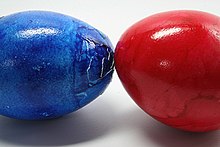Easter egg tables
The Easter egg tickling (also: Easter eggs "ticking", "düpfen", "ditschen", "tüppen", "tippen", "kitschen", "gecksen", "pecken", "tütschen", "dotzen", "boxen"), "Klöckeln" or "kick" - dialect for "collide") is an old Easter custom , which in its kind carried out as a competition mainly in the Bavarian Upper Palatinate , in many regions of old Bavaria , in South Tyrol , in many regions from Austria to the Balkans as far as Russia , in German-speaking Switzerland , but also in the Rhineland , Luxembourg and parts of Sweden . Two players each take a hard-boiled Easter egg in their hand. A player starts and hits the tip of his opponent's ice with the tip of his ice, with the intention of breaking the opponent's shell. In the family, the Easter egg table is played in turn at the table on Easter morning. The winner is whose egg is the only one still intact at the end.
In Bavaria it is called "Oabecka" (egg pecks) or regionally also "Oarhiartn" (hatching eggs), in the northern Upper Palatinate it is called in the dialect: "Oiastoußn" (egg-pushing), "Oiaboxn" (egg boxes), "Oiapecken" or "Oierhiartn" (hatching eggs). In Austria they say z. B. in Carinthia “Aalan tuatschn”, whereby the eggs themselves are called “Tuatscha”; In Lungau in the state of Salzburg they say “Oalala tutschen” (little eggs collide), in the rest of Austria they usually speak of “egg pecking”. In German-speaking Switzerland it is simply called "Eiertütschen", in northwestern Switzerland it is "Eiertätschen". In Aalen , Württemberg , the game is called "Spitzarschen". In Luxembourgish one knows the “técken” of the Easter eggs, with the point (“Spëtz”) or the blunt end (“Aasch”).
Cologne
In Cologne the game, originally only played by boys, is called “kippe” or “kippen”, an expression for “knocking off the tip” that is also used in Westphalia (mostly “kitschen” here) and Holstein . The word can also be recognized with the same meaning in the Anglo-Saxon “forcippian” or the Provencal “cepa”.
The first records of the “Easter egg kippe” date back to 1810. Groups of boys hit the tips, the blunt end (“carrion”) or the sides (“huddling”) of the Easter eggs on the streets at Easter. Whose egg remained whole was the winner and won the opponent's copy. Today the game is played by girls and boys, with the eggs usually remaining in the possession of the player.
Upper Palatinate
The folklorist Franz Xaver von Schönwerth from Upper Palatinate described this Easter game as early as 1890: “Two eyes collide, first pointed to pointed, then pointed to ass or vice versa. Whose eye breaks, loses it to the other. "
The "Oierhiartn" has been eagerly cultivated for decades, especially in the Upper Palatinate town of Mitterteich ( Tirschenreuth district ). On Easter Sunday after lunch, the participants meet there at Johannisplatz. When the weather is nice, there are often 50 to 60 people. Children and adults compete against each other. You “start” as it turns out. With the saying: "Point on point - jerk on jerk", the eggs are pushed against each other first with the point and then with the back. Whose egg is broken is the loser and gives his to the opponent . If, on the other hand, the egg game is still a draw, you bump the eggs together. A final decision is then due here. This is how almost everyone competes against everyone. The "Oierhiartn" lasts until no two can be found who can compete against each other with an intact egg.
Allgäu
In Leutkirch im Allgäu , the custom of “Easter egg dumming” has been cultivated since the beginning of the 19th century, and the “Klöcklesmarkt” is held on Easter Monday. Easter eggs are beaten against each other "point on point and head on head". Whose egg breaks twice must leave the egg to the winner.
Switzerland
In various places, such egg tarts or similar customs are carried out on Easter days . Here are some public bags that have been regularly recorded for decades . Of course there are countless religious, private and family events of the same kind.
- Bern . On Easter Sunday on Kornhausplatz. This custom has been in use for a long time; there is at least one known source by Hans Eggimann , who documents the living custom in 1892. In earlier years there was a whole range of Easter customs in the city of Bern, but this has completely disappeared.
- Zurich . On Easter Monday the Zwänzgerle at the house of the male "under the bows".
physics
The hardness and thickness of the eggshell are decisive for the outcome of the Easter egg treat . In addition to lifestyle and diet, these factors largely depend on the age of the chicken . Young chickens can take in and store more calcium from the diet , resulting in harder eggshells. As a result, the shell of the eggs of young hens can be twice as hard as that of older animals. In addition to the natural factors, the angle at which the two eggs meet is also crucial.
If a participant is only ever on the winning side, he is suspected of having started with a plaster egg or bad luck. Pitch eggs are blown-out eggs that are filled with liquid pitch and become rock hard after the filling has cooled down. Such were often used in the past.
See also: stress trajectories
Individual evidence
- ↑ Luxembourg Dictionary, Vol. 3, 1970, p. 300.
- ^ Adam Wrede : New Cologne vocabulary . Second volume, Greven Verlag, Cologne, 8th edition 1981
- ↑ Schwäbische Zeitung, April 21, 2014
- ↑ See Schweizerisches Idiotikon Vol. XIII Sp. 2181 middle, article (egg) bags
- ↑ ( page no longer available , search in web archives )
- ↑ ( page no longer available , search in web archives )
- ^ Frank Massholder: What is eggshell: Eggs: definition, product knowledge, food science. Retrieved April 15, 2020 .


